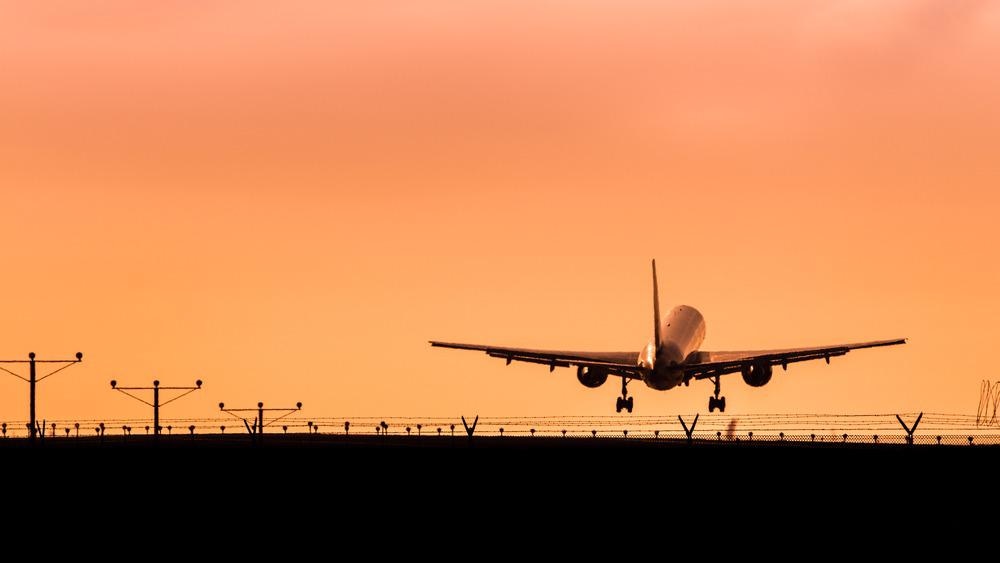
Image Credit: PTZ Pictures/Shutterstock.com
Aircraft often have to alter their course if they encounter unfavorable weather conditions – sometimes flying hundreds of miles off course to avoid electrical storms. Being able to predict unforeseen severe weather events by capturing accurate weather data could prevent such deviations, and in the long run, help the industry reduce its impact on the environment and climate change.
Aircraft Emission Problems
In the 1960s, the total annual worldwide passenger count stood at 1 million. By 2017, this had risen to 4 billion travelers. In 2019, international flights produced a staggering 915 million tons of carbon dioxide. This well-known greenhouse gas traps the sun’s heat in the atmosphere, causing global temperatures to rise.
Aviation accounts for 2.4% of human-caused global carbon dioxide emissions, and its impact on climate change will increase as the concentration of carbon dioxide grows. The lifespan of the gas is measured in centuries, so today’s emissions are combining with those pumped out during the Industrial Revolution.
High-Tech Solutions
Monitoring the weather more accurately could allow airlines to make simple tweaks to their flight paths when necessary to avoid headwinds, or take advantage of favorable winds at altitude, for example, which could have the overall benefit of reducing emissions and the industry’s impact on climate change.
“Historically, routing decisions have been made using worst-case weather scenarios which tend to be more operationally restrictive,” explains Renny Vandewege, Vice President of Weather Operations at DTN. “With advanced forecasting capabilities, airlines have access to more accurate, detailed, and specific data for flight management.”
DTN has developed a highly configurable software-based aviation weather system to help airlines minimize risk, increase efficiency and assist in decision making by providing real-time, reliable data on weather conditions. It is used in more than 300 airports worldwide to gather, manage and circulate local environmental information to provide safer and more efficient flights.
“Having near-pinpoint accuracy in detecting dangerous weather conditions, such as clear air turbulence, allows pilots to make smaller, calculated shifts in their route, rather than having to fly hundreds of miles out of their way to avoid a speculated event, saving not just time, but fuel as well,” says Vandewege.
Specific weather insights for long-range route planning, as well as for real-time tactical flight management, may mean the difference between not loading extra fuel as a precaution for alternative landing options or circling an airport before eventually landing, he adds. “Using weather analytics in all of these scenarios enables the aviation industry to use less fuel and reduce carbon emissions.”
Contrail Conundrum
It is not just carbon dioxide emissions that are problematic. The contrail clouds that follow aircraft across the skies also trap heat in the Earth’s atmosphere, causing temperatures to rise. They are formed when aircraft cruise above 26,000 feet; water vapor from their engines quickly saturates the already moist air and then condenses and freezes into tiny ice crystals.

Research has found that contrail clouds trap heat in the Earth's atmosphere, causing temperatures to rise. Image Credit: Aerial-motion/Shutterstock.com
A flight from London to San Francisco generates 55 tons of carbon dioxide equivalent per person – that is more than double the emissions a typical family car produces in one whole year. Worse still, contrail formation has double the climate impact as aircraft engine emissions, accounting for 60% of the industry’s total.
Smarter Flight Plans
Cambridge-based SATAVIA has used data analytics and artificial intelligence to study aircraft contrail formation. They modeled the Earth’s atmosphere from the ground level, right up to space. Their high-resolution replica can quantify atmospheric changes in heat, sunlight, moisture, pressure, temperature, humidity, clouds, and wind speed.
“Using our numerical weather prediction model, we can generate a ‘digital twin’ of the atmospheric environment from ground-level to top of atmosphere – around 328,000ft,” said Dr Adam Durant, founder and CEO of SATAVIA. “Our model performs around 100 algorithmic computations over four billion model cells every 30 seconds for 26 meteorological parameters, generating one quadrillion –1,000 trillion – computations per simulation day!”
This data allows aircraft operators to forecast, quantify, avoid and even offset aviation contrails by optimizing flight plans. The company believes 60% of aviation’s footprint could be wiped out with smarter route planning.
How SATAVIA is making aviation cheaper, smarter and greener
Video Credit: SATAVIA/YouTube.com
The Future of Atmospheric Modeling
Climate change increases the chances of extreme weather and related events such as forest fires. High-tech atmospheric modeling can help the aviation industry reduce its impact on climate change through smarter planning of routes, while advanced weather forecasting enables airlines to predict weather conditions better and avoid unnecessary deviations to dodge extreme weather.
Such measures can reduce fuel usage, emissions, and the overall impact on the environment. Importantly, the benefits of using high-tech weather forecasting and advanced atmospheric modeling are immediate and less expensive than other emission-cutting technologies.
References and Further Reading
DTN, Accurate monitoring with independent sensors, DTN [Online] https://www.dtn.com/weather/weather-environmental-solutions/. Accessed 18 March 2021.
Scialom, M. (2021) Satavia’s smart technology can reduce aviation’s climate impact by 60%, Cambridge Independent [Online] https://www.cambridgeindependent.co.uk/business/satavia-s-smart-technology-can-reduce-airline-emissions-by-60-9154733/. Accessed 18 March 2021.
Camero, K. (2019) Aviation’s dirty secret: Airplane contrails are a surprisingly potent cause of global warming, Science [Online] https://www.sciencemag.org/news/2019/06/aviation-s-dirty-secret-airplane-contrails-are-surprisingly-potent-cause-global-warming. Accessed 18 March 2021.
University of Reading (2021) Aircraft could cut emissions by better surfing the wind, ScienceDaily [Online] https://www.sciencedaily.com/releases/2021/01/210125191835.htm. Accessed 18 March 2021.
Disclaimer: The views expressed here are those of the author expressed in their private capacity and do not necessarily represent the views of AZoM.com Limited T/A AZoNetwork the owner and operator of this website. This disclaimer forms part of the Terms and conditions of use of this website.